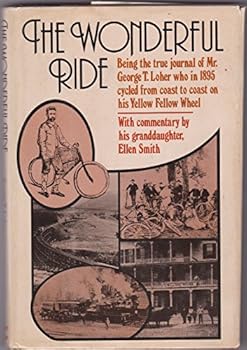The Wonderful Ride: Being the True Journal of Mr. George T. Loher Who in 1895 Cycled from Coast to Coast on His Yellow Fellow Wheel
The wonderful ride: Being the true journal of Mr. George T. Loher who in 1895 cycled from coast to coast on his Yellow Fellow wheel [Hardcover] This description may be from another edition of this product.
Format:Hardcover
Language:English
ISBN:0062505408
ISBN13:9780062505408
Release Date:January 1978
Publisher:HarperCollins Publishers
Length:146 Pages
Weight:0.75 lbs.
Customer Reviews
2 ratings
Great read for several reasons
Published by Thriftbooks.com User , 16 years ago
The simple journal format of this book brings to life what daily life was like in various communities back in 1895. Imagine trying to cross the country when you had to wade across most of the waterways, or wake up a ferryman to take you across the larger rivers, or knocking on the door of a cabin for a meal and shelter simply because it was the only building you had seen for several hours and nightfall was approaching. Imagine riding over rough terrain without the help of bicycle brakes or multiple speed gears. Imagine creating such a stir in the towns you pass through that newspaper reporters interview you... just because you are riding a bicycle! How the world has changed. Is it better now? Read this and decide.
Finding the Real America in 1895
Published by Thriftbooks.com User , 27 years ago
In 1895 the bicycle was the focus of social high-society. It was the fastest vehicle on the road and was villified piano makers and bar owners due their loss of business due to the purchase of bicycles (which cost about a third of a years wages) by potential customers! George T. Loher was a butcher in Oalland, California and an enthusiastic "wheelman," as cyclists were known then. He rode daily, did not drink and raced. The trip he undertook was not like the cyle tours done today; there were no paved roads, and very few services. Mr. Loher was not the first to ride across the U.S. Thomas Stevens had already done it years before on a Penny-Farthing (high-wheeler) anmd had gone on to ride around the world. So this was not a new adventure for cyclists, but is was an adventure nonetheless. George Loher rode a bicycle similar to the ones we ride today, except he did not have gears (in fact his was a direct-drive bike - no coasting)or any brakes. On downhills he would simply hold his feet up to coast, or if the hill was very steep, tie a tree branch to his bike to slow himself down. One new thing he used was pneumatic tire, some of the first made for bicycles (none had been used for any other purpose yet). His route took him from Oakland through Northern California, Oregon, Idaho, Montana, over to Minnesota, down to Chicago and on to New York City. Along the way he describes the America he saw in detail and tells us things we may never have known. He rode on train rights-of -way becasue there sere no roads. He stayed with people all along the way who help, and hindered him (children would stick pins in his tires to hear the air come out!). He had to wade creeks, walk miles with a broken bike and eat at inhospitable inns. In North Dakota and Minnesota he wonders why anyone would travel to Germany or Norway since they could come here instead and visit areas where no one spoke english! Through it all he keeps his sense of adventure and keeps on going. Upon his arrival in New York he is treated like a hero and feted in the highest society. Mr. Loher never published the story he wrote. He felt is was too ordinary. His grand-daughter found his manuscript in the late 1970's and published it for him, lucky for us!






